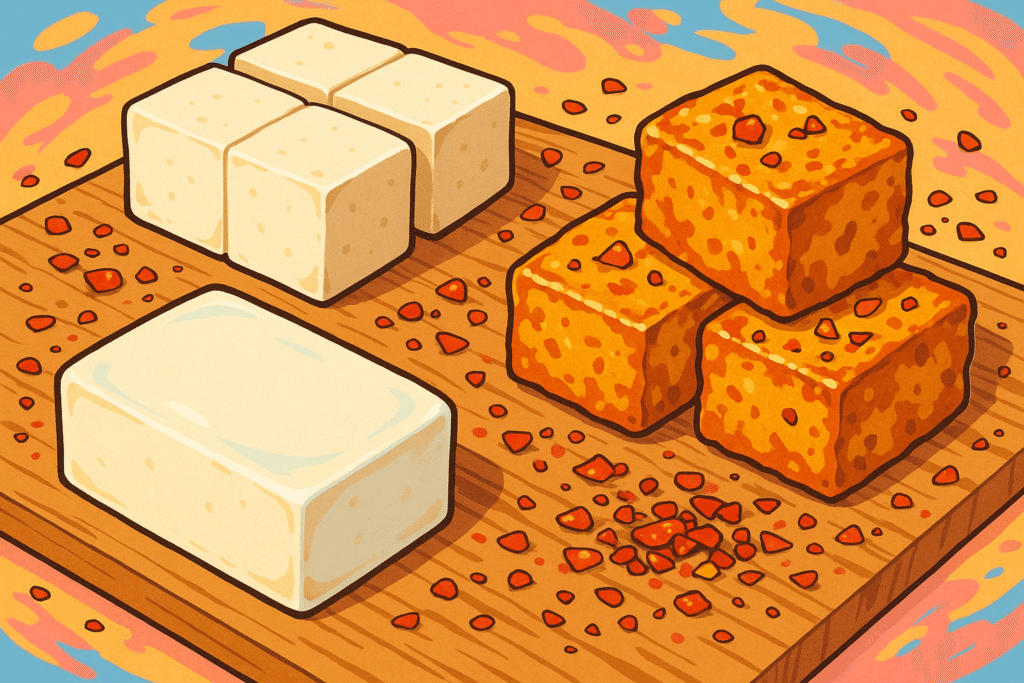Tofu ()

About Tofu
Tofu, also known as bean curd, is a mild, protein-rich food made by coagulating fresh soy milk from Glycine max (soybeans) and pressing the resulting curds into blocks. Its neutral taste and pillowy, custard-like texture make it a culinary chameleon. Tofu soaks up surrounding flavors—think spicy mapo tofu, silken tofu soups, or crispy-fried cubes tossed in chili oil—and adapts beautifully to grilling, braising, steaming, and blending. It’s celebrated for balancing lightness and satisfying richness, making it integral not only in Chinese and Japanese kitchens but also throughout Southeast Asia, Korea, Vietnam, and beyond.
The History of Tofu
Tofu traces its roots to China, with most historical accounts placing its invention during the Han dynasty (circa 2nd century BCE). Legend credits Prince Liu An for discovering the process, but the truth may be more prosaic: early Chinese cooks found that adding natural mineral salts to hot soy milk created soft, nutritious curds. Tofu traveled alongside Buddhist monks to Japan (where it became known as tōfu) and throughout much of East and Southeast Asia. It quickly won favor in vegetarian and temple cuisines, esteemed for its ability to provide nourishment without animal products. Over the centuries, regional styles and preparations flourished, giving rise to iconic renditions like Japanese agedashi tofu, Korean sundubu jjigae, or Vietnamese đậu phụ chiên.
The Science of Tofu
Tofu production begins with the humble soybean, one of the planet’s richest sources of plant-based protein. After soaking, grinding, and boiling, soybeans yield soy milk, which is then coagulated using mineral agents such as calcium sulfate (gypsum), magnesium chloride (nigari), or glucono delta-lactone. The choice of coagulant—and the firmness of pressing—determines tofu’s final texture, from delicate silken to resilient extra-firm. Nutrition-wise, tofu shines with high-quality protein, all nine essential amino acids, low saturated fat, and minerals including iron, calcium, and magnesium. Isoflavones and saponins, naturally occurring in soy, are linked to potential health benefits like cholesterol regulation and antioxidant activity.
The Geography of Tofu
Tofu’s journey began in China and soon found fertile ground across East and Southeast Asia. In northern China, tofu is often denser and pressed; southern styles favor smooth, delicate curds. Japan’s regions each celebrate their own tofu specialties, from creamy kinugoshi (silken) tofu in Kyoto to hearty momen (firm) styles elsewhere. Korea enjoys both fresh and aged tofu—think sundubu (ultrasoft) in stews and pronouncedly chewy varieties for grilling. Vietnamese and Thai cuisines draw on deep-fried and fresh tofu cubes as street snacks or vegetarian staples. Even far beyond Asia, tofu is now widely produced and appreciated, with each region adapting local soybeans, pressing methods, and culinary traditions to its own palate.
Varieties of Tofu
Silken Tofu (Kinugoshi, Sundubu)
Smooth, creamy, and very delicate—sometimes almost pudding-like. Often used cold in salads, floating in soups, or as a vegan substitute in custards and dressings.
Soft Tofu
Tender but slightly more structured than silken. Key in soups, hotpots, and lightly stir-fried dishes. Absorbs flavors while retaining a soft bite.
Firm Tofu (Momen)
Pressed for more density. Holds its shape when stir-fried, grilled, or braised—classic in many Chinese stir-fries and Vietnamese dishes.
Extra-Firm Tofu
Dense, springy, and least watery. Best for frying, skewers, or crumbling as a meat replacement. Its texture stands up well to marinades and intense seasonings.
Fermented Tofu (Furu, Chao)
Aged in rice wine or brine until creamy, tangy, and funky. Used as a condiment, spread, or flavoring in hotpots, congee, and vegetables.
Smoked or Five-Spice Tofu
Flavored, pressed, and often dark in color. Sliced cold, tossed into salads, or added to braises for a smoky note.
FAQs All your questions about Tofu: answered
Is tofu always vegan?
Traditional tofu is plant-based, made only from soybeans, water, and coagulant. Some processed versions may contain flavorings or additives, so check labels if you have dietary restrictions.
Does tofu need to be cooked before eating?
Soft and silken tofu can be eaten raw—simply drain and dress as desired. Firm varieties are often enjoyed cooked for better flavor and texture, but there’s no need to cook tofu for food safety if it’s fresh and handled properly.
How do I make tofu crispier?
Pat firm tofu dry, press to remove excess moisture, and toss in a thin layer of starch before frying or baking. High heat and minimal crowding in the pan help develop that coveted golden crust.
What’s the difference between silken and firm tofu?
Silken tofu uses a gentler coagulant and is barely pressed—yielding a creamier texture, ideal for soups and desserts. Firm tofu is pressed longer, creating a denser, bouncier block fit for stir-fries, grilling, or frying.
Is tofu good for you?
Yes—when enjoyed as part of a balanced diet, tofu contributes complete protein, minerals, low saturated fat, and beneficial isoflavones, making it a healthy and sustainable protein choice.